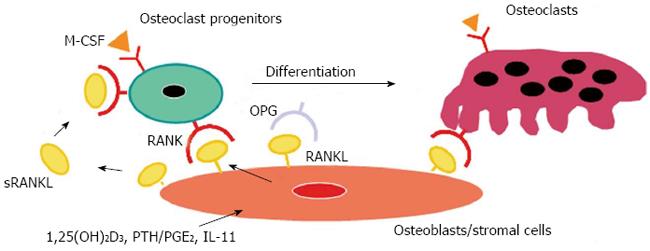Copyright
©2013 Baishideng Publishing Group Co.
World J Orthop. Oct 18, 2013; 4(4): 207-217
Published online Oct 18, 2013. doi: 10.5312/wjo.v4.i4.207
Published online Oct 18, 2013. doi: 10.5312/wjo.v4.i4.207
Figure 1 A model illustrating a mechanism by which osteoblasts/stromal cells regulate osteoclast differentiation and activation.
Three distinct signals stimulated by 1,25(OH)2D3, PTH/PGE2, and interleukin (IL)-11 induce receptor activator of nuclear factor-κB ligand (RANKL) expression on osteoblasts/stromal cells. RANKL mediates a signal for osteoclastogenesis through RANK produced on osteoclast progenitors. Osteoprotegerin (OPG) inhibits osteoclastogenesis by interrupting the binding of RANKL and RANK. Macrophage colony-stimulating factor (M-CSF) produced by osteoblasts/stromal cells is also indispensable for proliferation and differentiation of osteoclast progenitors. Soluble RANKL (sRANKL) is produced by digestion of RANKL with metalloproteinases and may regulate osteoclastogenesis.
- Citation: Yasuda H. RANKL, a necessary chance for clinical application to osteoporosis and cancer-related bone diseases. World J Orthop 2013; 4(4): 207-217
- URL: https://www.wjgnet.com/2218-5836/full/v4/i4/207.htm
- DOI: https://dx.doi.org/10.5312/wjo.v4.i4.207









